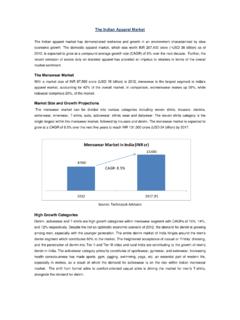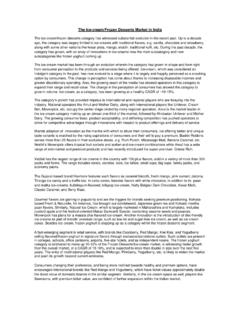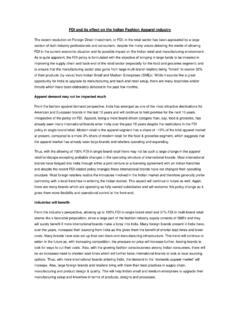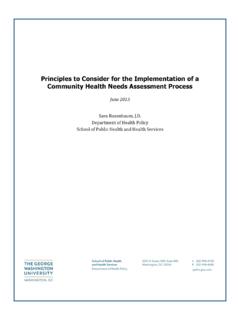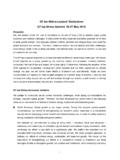Transcription of India’s Food Sector - technopak.com
1 India's Food Sector Cashing in on Forthcoming Opportunities Whitepaper | January 2014. Tarun Jain, Vice President About the Whitepaper Agriculture Sector continues to remain the economy's backbone, even though India is moving towards a services-led economy. Agriculture and food processing, being one of the priority sectors, the Indian Government has backed it up through adequate policy frameworks, financial support, and other initiatives at various levels. The food processing Sector has a huge business potential and presents varied opportunities for investment across the entire food value chain. It also offers tremendous growth potential in the areas of value-added processing and food retailing. The Sector has registered growth in investment over the past few years, and we firmly believe that the Sector has much more to offer to domestic and international investors, in all aspects of growth and business. This report addresses some of the key interventions that are necessary to ensure a sustained impetus for the Sector 's growth, both at the farm level and the processing level.
2 It also highlights key sectors within food processing for which a rapid growth is anticipated in the years to come; key business opportunities within these sectors are also spelt out. This report also focuses on the investment potential and stresses on the key challenges that need to be addressed. Food Division Services Business Strategy Sector Opportunity Scan Opportunity Assessment Industry/ Sector Specific Snapshot India Entry Strategy/Market Entry Strategy Define Processing Mix or Crop Mix Competitive Assessment Marketing and Procurement Planning Business Plan Development Equipment, Machinery and Infrastructure Business Expansion Plan Planning Land Use Planning Supply Chain Assessment Develop Detailed Business Plan Supply Chain Strategy Inventory, Warehouse and Logistics Management Implementation Assistance Process Re-Engineering Project Management Consulting Construction Management Support Performance Audit Revitalize Business Positioning Partner Search Evaluate Product, Price, Market, and Location Strategy Business Strategy for the Local Market Address Opportunities for Improvements Identify and Shortlist Prospective Partner Conduct and Establish Plant Audit Process Schedule Meetings Signing of MoU and Partner Selection Turnkey Solutions Feasibility Studies.
3 Business Planning Sector /Consumer Insights Technology/Machinery Selection Trends and Consumption Insights Product Selection and Development Segmentation Studies Implementation Support Product Testing Contents 1 8 12. Overview of India's Key Influencers Notable Trends Agriculture and Food Processing Sector 14 16 20. Investment Institutional Key Issues and Opportunities Framework Challenges and Government Support 22. Our Suggestions Author: Tarun Jain | Vice-President Design & Development: Arvind Sundriyal | Assistant Manager-Design Foreword India has successfully managed to achieve self-sufficiency in food, with a marginal surplus, with 260 million tons of food grain production in 2012-13. Additionally, the agriculture Sector offers many opportunities in food processing, food retailing, and exports. The Indian food processing market is growing rapidly at a CAGR of and this is expected to rise to 12-15% in the next five years. Value-added processing has registered an accelerated growth, thanks to changing lifestyles and consumption patterns.
4 Consumers' behavior vis- -vis food consumption has undergone significant changes primarily as a result of the heightened awareness about different value-added food products, brands, and cuisines, and also their greater willingness to experiment and ability to pay. Consequently, food businesses are undergoing a noticeable shift. Besides the resetting of the demand equation, production capacities and government policies are also playing a major role in transforming food businesses. Many such sectors as dairy, health foods, ready-to-eat, organic foods, fruit juices, and other packaged foods have recorded a high growth over the years. In 2012, even the exports of major food items posted an annual growth of 40%, over the previous year. Some food items like processed vegetables, dairy products, fresh F&V, and non-basmati rice have witnessed a significant growth in exports. This growth in the Sector has been aided by significant improvements in product and packaging quality, alongside the increased investment and participation by the private Sector .
5 The Government of India's policy thrust, alongside revised investment guidelines, has facilitated the growth in Foreign Direct Investment (FDI) inflows into the agriculture and food processing sectors, resulting in a CAGR of 37%, over the past five years. India has witnessed an increase in investments into domestic companies engaged in dairy and meat processing, and confectionaries, among others. Despite all this, the challenges are still intact - production capability, lack of quality produce, and inadequate marketing, storage, and processing infrastructure still need to be tackled in order to unleash the true potential of the Sector . While the huge gap in output between agriculture and food processing is a major cause for concern, the government has increased its expenditure towards these sectors. This is expected to raise the value of output, the Sector 's share in the global processed food market, and also boost rural income levels. The Ministry of Food Processing Industries (MoFPI).
6 Has planned an outlay of INR 15,000 crore into the Sector vide the 12th Five Year Plan, which is about three times the outlay approved under the 11th Five Year Plan. Again, about 66% of this investment will be directed towards food infrastructure development. This is expected to generate significant investment opportunities within the Sector , for both domestic as well as international food players. Thus, the Indian food processing industry is poised for phenomenal growth in the years to come. There is the expectation of enhanced investment and the participation of domestic and international players within the Sector which will further contribute to its growth and development, will create new capital infrastructure, better technology, and improved product quality. At the same time, India needs to gear up to investor expectations by ensuring the necessary support infrastructure and adequate policy backing. Overview of India's Agriculture and Food Processing Sector Indian Agriculture: An Overview The agriculture Sector contributes 14% of the nation's GDP and 11% of its exports.
7 About 50% of India's population depends on agriculture for their primary source of income. India has successfully managed to gain self-sufficiency in food, with a marginal surplus in production, and is among the leading global producers of cereals, fruits & vegetables, and dairy products. Exhibit 1 Percentage Share of Agriculture and Food Processing in India's GDP. Industry Share of GDP (%) CAGR (%). Agriculture 14% Manufacturing Food Processing Industries Industry Source: Ministry of Food Processing Industries, GoI. 1. India's Food Sector : Cashing in on Forthcoming Opportunities | January 2014. India, with of the world's geographical area and 4%. of its water resources, supports about 17% of the world's human population and 15% of the livestock With 260 million tons of food grains and 227 million tons of fruits & vegetables produced annually, India is the top producer of many such agricultural products as bananas, mangos, guavas, rice, and wheat, and occupies a very important place in the world's total production basket (Exhibit 2).
8 The country's major crops include rice, wheat, sugarcane, oilseeds, pulses, jowar, bajra, ragi, tea, coffee, coconut, cashew, spices, cauliflower, onion, cabbage, mango, banana, sapota, acid lime, etc. Farm production has, however, been shifting towards horticulture crops from coarse cereals and oilseeds as these achieve better returns. Other major reasons for such a shift include changing lifestyles, shift in food consumption habits and needs, and higher disposable incomes. The agriculture Sector generates export opportunities for many products including basmati rice, guar gum, buffalo meat, jaggery, groundnut, and fresh fruits & vegetables. Between fiscal 2008-12, India's exports of processed food and related products increased at a CAGR of 27%. The main export destinations for Indian food products have been the Middle East and Southeast Asia. Over the past decade, the growth of the agriculture Sector has slowed to from 6%. This downfall can be attributed to the continuous breaking of land holdings into smaller pieces, a shift from agriculture to other sources of income, degradation of soil quality, and increasing urbanization and industrialization.
9 Accelerating the growth of agriculture production is therefore necessary not only to achieve an overall GDP target and meet the rising demand for food, but also to increase the incomes of those dependent on agriculture and thus ensure inclusiveness. Growth in the agriculture Sector will also ensure that the urban-rural divide does not widen any further. Exhibit 2 Indian Agricultural Production and Global Share Production (MT), FY'12 Global Share Global Rank Milk 127 17% 1. Pulses 7 18% 1. Buffalo Meat 3 43% 1. Banana 30 28% 1. Mango and Guava 15 39% 1. Tea 1 23% 2. Rice 156 24% 2. Sugarcane 278 24% 2. Wheat 94 10% 2. Source: IBEF, Technopak Advisors 2. Food Processing Sector : An Overview In India, most food is consumed in fresh form and only a small quantity is processed for value addition. However, with this trend changing gradually, the market for processed food products is expanding in India. Increased mobility and aspirations, the exposure to and the availability of a wider range and products, easily available credit facilities, and higher disposable incomes have resulted in greater spending and consumption.
10 Among the affluent and middle-income classes, the share of expenditure on food vis- -vis other consumption categories has declined, despite the fact that the total expenditure on food has increased across all classes. Initially, food expenditure was concentrated on basic items like grains, vegetable oils, and sugar. However, there is now an increase in the inclusion of fruits & vegetables, eggs, meats, beverages, and processed foods, thanks to both increased availability and affordability. There has been an accelerating shift from food security to nutritional security and convenience foods in the recent past. According to the MoFPI, Government of India (GoI), the Food Processing Industry (FPI) contributes of India's GDP and provides direct employment to 13 million people. The industry is dominated by many small scale enterprises and involves limited value addition. The FPI has grown at a CAGR of over the past five years, whereas registered food processing units are growing at 11%. Exhibit 3 Market Size of Indian Food Sector (INR 000 cr).
